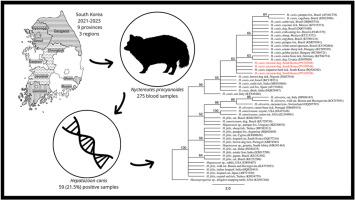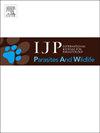First description of Hepatozoon canis in raccoon dog (Nyctereutes procyonoides)
IF 2.2
3区 医学
Q3 ECOLOGY
International Journal for Parasitology-Parasites and Wildlife
Pub Date : 2025-09-02
DOI:10.1016/j.ijppaw.2025.101132
引用次数: 0
Abstract
Hepatozoon canis is a tick-borne apicomplexan parasite that primarily infects domestic and wild canids. While its presence has been documented globally, previous studies have reported its absence in raccoon dogs (Nyctereutes procyonoides) in Europe, and its status in Asian populations remains unclear. This study presents the first molecular detection of H. canis in raccoon dogs in South Korea. Between 2021 and 2023, blood samples from 275 raccoon dogs admitted to 9 wildlife centers were analyzed using PCR targeting a partial sequence of the 18S rRNA gene. Overall, 21.5 % of samples tested positive, with the highest prevalence observed in the southern region (38.2 %) and the lowest in the north (8.8 %) in South Korea. Sequencing of amplicons revealed high similarity to H. canis found in a Japanese hard tick (Ixodes nipponensis) also from South Korea. Remarkably, the infection rate in raccoon dogs was significantly higher than previously reported in Korean domestic dogs (0.2–0.9 %) and ticks (0.09 %), indicating raccoon dogs may function as key sylvatic reservoirs. These findings suggest the possibility of alternative transmission pathways including predation or vertical transmission. Given the expanding raccoon dog population and thus increasing contact with domestic animals and shared habitats, their role in the ecology of H. canis and other tick-borne pathogens merits attention. This study underscores the importance of wildlife disease surveillance within the One Health framework and highlights the need for further research into host–vector dynamics and potential spillover risks at the wildlife–domestic animal interface.

貉犬肝虫病首次报道(原yonoides Nyctereutes)
犬肝虫是一种蜱传的顶端复合寄生虫,主要感染家养和野生犬科动物。虽然它的存在在全球范围内都有记录,但先前的研究报告称,它在欧洲的貉(Nyctereutes procyonoides)中不存在,而且它在亚洲种群中的状况仍不清楚。本研究首次在韩国貉中检测到犬嗜血杆菌。在2021年至2023年期间,研究人员使用针对18S rRNA基因部分序列的PCR方法,分析了9个野生动物中心收治的275只浣熊的血液样本。总体而言,21.5%的样本检测呈阳性,韩国南部地区的患病率最高(38.2%),北部地区最低(8.8%)。扩增子序列显示与同样来自韩国的日本硬蜱(Ixodes nipponensis)中发现的犬血蜱具有高度相似性。值得注意的是,貉的感染率明显高于韩国家犬(0.2 - 0.9%)和蜱(0.09%),表明貉可能是主要的森林宿主。这些发现表明可能存在其他传播途径,包括捕食或垂直传播。考虑到浣熊数量的增加以及与家养动物和共享栖息地的接触的增加,它们在犬嗜血杆菌和其他蜱传病原体生态中的作用值得关注。这项研究强调了在“同一个健康”框架内监测野生动物疾病的重要性,并强调需要进一步研究宿主-媒介动力学和野生动物-家畜界面的潜在溢出风险。
本文章由计算机程序翻译,如有差异,请以英文原文为准。
求助全文
约1分钟内获得全文
求助全文
来源期刊

International Journal for Parasitology-Parasites and Wildlife
Medicine-Infectious Diseases
CiteScore
3.80
自引率
5.60%
发文量
113
审稿时长
45 days
期刊介绍:
The International Journal for Parasitology: Parasites and Wildlife (IJP-PAW) publishes the results of original research on parasites of all wildlife, invertebrate and vertebrate. This includes free-ranging, wild populations, as well as captive wildlife, semi-domesticated species (e.g. reindeer) and farmed populations of recently domesticated or wild-captured species (e.g. cultured fishes). Articles on all aspects of wildlife parasitology are welcomed including taxonomy, biodiversity and distribution, ecology and epidemiology, population biology and host-parasite relationships. The impact of parasites on the health and conservation of wildlife is seen as an important area covered by the journal especially the potential role of environmental factors, for example climate. Also important to the journal is ''one health'' and the nature of interactions between wildlife, people and domestic animals, including disease emergence and zoonoses.
 求助内容:
求助内容: 应助结果提醒方式:
应助结果提醒方式:


